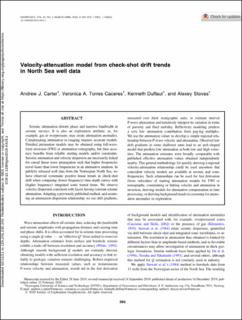| dc.description.abstract | Seismic attenuation distorts phase and narrows bandwidth in seismic surveys. It is also an exploration attribute, as, for example, gas or overpressure, may create attenuation anomalies. Compensating attenuation in imaging requires accurate models. Detailed attenuation models may be obtained using full-waveform inversion (FWI) or attenuation tomography, but their accuracy benefits from reliable starting models and/or constraints. Seismic attenuation and velocity dispersion are necessarily linked for causal linear wave propagation such that higher frequencies travel faster than lower frequencies in an attenuative medium. In publicly released well data from the Norwegian North Sea, we have observed systematic positive linear trends in check-shot drift when comparing (lower frequency) time-depth curves with (higher frequency) integrated sonic transit times. We observe velocity dispersion consistent with layers having constant seismic attenuation. Adapting a previously published method, and assuming an attenuation-dispersion relationship, we use drift gradients, measured over thick stratigraphic units, to estimate interval P-wave attenuation and tentatively interpret its variation in terms of porosity and fluid mobility. Reflectivity modeling predicts a very low attenuation contribution from peg-leg multiples. We use the attenuation values to develop a simple regional relationship between P-wave velocity and attenuation. Observed low drift gradients in some shallower units lead to an arch-shaped model that predicts low attenuation at both low and high velocities. The attenuation estimates were broadly comparable with published effective attenuation values obtained independently nearby. This general methodology for quickly deriving a regional velocity-attenuation relationship could be used anywhere that coincident velocity models are available at seismic and sonic frequencies. Such relationships can be used for fast derivation (from velocities) of starting attenuation models for FWI or tomography, constraining or linking velocity and attenuation in inversion, deriving models for attenuation compensation in time processing, or deriving background trends in screening for attenuation anomalies in exploration. | en_US |
